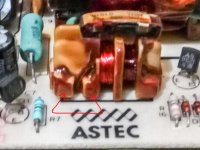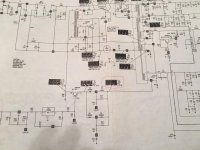This one has me stumped. I have replaced all caps and still have the same symptom. When I power on with just a bare II+ or IIe (no cards) it will just tick for awhile (maybe a few seconds)then beep and boot ok. The more load I put on like adding a memory card, the longer it has to warm up before it will boot ok. When it finishes booting, the outputs measures a rock solid +5.0V, -5.0V, +12.2V, -12.2V and varying the AC120V up and down with a variac +- 5V or so all the output voltages remain solid. There is a shutdown SCR monitoring the +12V line which Sams ComputerFacts CC1 shows as 11.7V so maybe 12.2V is a little high? I'm pretty sure by using my scope that the SCR is firing causing the tick cycle. Any thoughts? My only thought at the moment is the type of caps I put in? I remember years ago in electronics class learning about the power factor of a capacitor. Would our modern day 'teeny' caps have a weak power factor?
Larry G
Larry G



